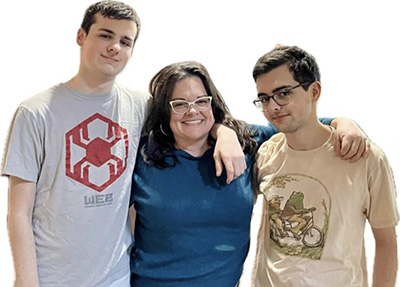Back-to-School Transitions: A Journey of Advocacy, Structure and Growth
August 29, 2025
By Crystal Orion, Family Services Coordinator, Alyssa Burnett Center

Left to right: Austin, Crystal, Ethan.
As a mother of two, the start of each school year has always been an emotional mix of excitement and challenge. My oldest son, diagnosed with autism at age 2, was once predicted never to speak, graduate high school, work or live independently. Today, I am proud to share that he recently graduated with a strong GPA, got into college and works. My youngest son — just 17 months younger — is now a senior in high school. Looking back, I can see how much intentional planning, advocacy and community support shaped their educational journeys.
From the beginning, I believed in early intervention. My oldest began school at age 2, and my youngest at just 18 months. Both loved the structure of school, though summers were difficult without that same consistency. I often searched for year-round options or enrolled them in summer school and camps. Sometimes I even attended as my son’s aide to make sure he had the support he needed. Structure, routine and preparation became cornerstones of our success.
One of the most valuable tools we developed was a one-page “All About Me” document. Each year, we shared it with teachers and staff to highlight strengths, challenges, interests, medications and strategies that worked best. This helped educators see my son as an individual, not just his disability, and gave him the chance to start the year with understanding and support. In addition to IEP meetings, we made sure he met teachers, toured classrooms, practiced routines and customized his desk and backpack so he could be as independent as possible from day one. There were times when my son wasn’t receiving a Free Appropriate Public Education (FAPE) in the Least Restrictive Environment (LRE). We had multiple IEP meetings to secure a 1:1 paraeducator so he could access general education classrooms. During the school year, I joined the PTSA as a Special Needs Liaison, helped organize playdates and sometimes trained summer camp staff on autism to ensure he could be included safely and successfully.
The transitions to middle school were especially challenging. My youngest was placed on a 504 plan, while my oldest cycled through several Non-Public Agencies (NPAs) until we found a good fit. Sadly, some placements didn’t work because he was being targeted by staff or peers. Still, we adapted, adjusted, and kept moving forward. By high school, both boys grew confident enough to advocate for themselves. They began writing their own 504s and IEPs, and instead of detailed “All About Me” forms, they emailed teachers directly to share what worked for them.
After graduating high school, my oldest was accepted into a reputable gaming college — an incredible milestone we celebrated. Unfortunately, the transition was not what we had hoped. There were no systems in place to support students with autism, and both staff and peers lacked awareness and education around disability inclusion. Even ADA laws were not being upheld until I hired an educational attorney. Faced with these barriers, my son made the difficult decision to withdraw after one quarter. Ultimately, his mental and emotional health came first. While college was not the right fit at that time, he has since found meaningful employment in a job he truly loves — a reminder that success can take many different paths.
Now, as my youngest prepares for his final year, I reflect on what I’ve learned:
- Know your child’s disability, but don’t let it define them.
- Teach self-advocacy — this skill will carry them beyond school.
- Every child learns and develops at their own pace.
- Don’t be afraid to speak up, challenge systems and ask for what your child needs.
- Adaptability is key — what worked last year may not work this year.
- Celebrate the wins, however small they seem.
Parenting a child with special needs requires resilience, patience and flexibility. There will be setbacks, but they are speed bumps — not roadblocks. Take a deep breath, lean on your village and remember that success looks different for every child.
As we enter a new school year, I hope our family’s journey reminds other parents that with preparation, advocacy and compassion, our children can thrive in their own way — one step, one teacher and one school year at a time.